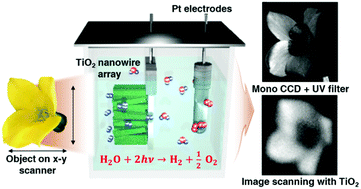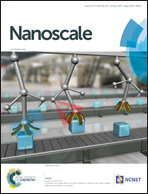How do plants see the world? – UV imaging with a TiO2 nanowire array by artificial photosynthesis†
Abstract
The concept of plant vision refers to the fact that plants are receptive to their visual environment, although the mechanism involved is quite distinct from the human visual system. The mechanism in plants is not well understood and has yet to be fully investigated. In this work, we have exploited the properties of TiO2 nanowires as a UV sensor to simulate the phenomenon of photosynthesis in order to come one step closer to understanding how plants see the world. To the best of our knowledge, this study is the first approach to emulate and depict plant vision. We have emulated the visual map perceived by plants with a single-pixel imaging system combined with a mechanical scanner. The image acquisition has been demonstrated for several electrolyte environments, in both transmissive and reflective configurations, in order to explore the different conditions in which plants perceive light.



 Please wait while we load your content...
Please wait while we load your content...